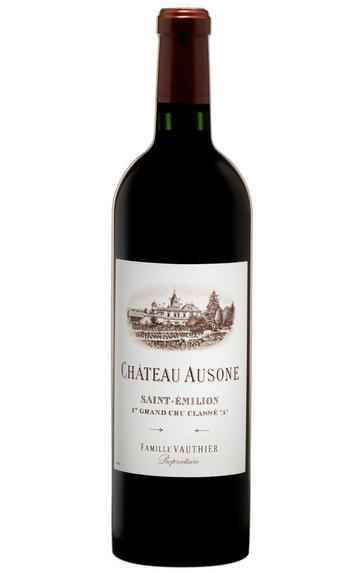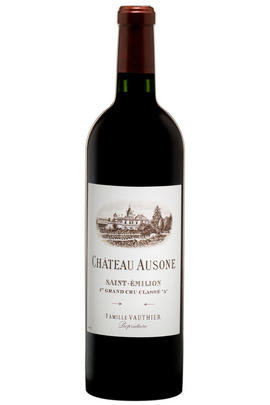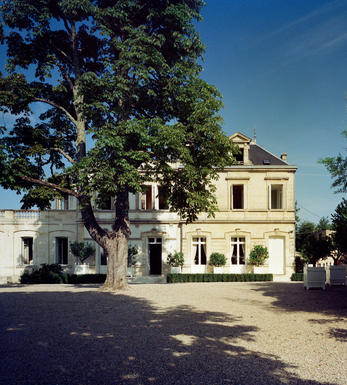
2021 Château Ausone, St Emilion, Bordeaux

Critics reviews
Violet edging, jewel red depths. There is austerity on the tannins here, but also great depths through the palate, with controlled but juicy loganberry and raspberry fruits, and waves of saffron, creamy red-fruit puree, crushed rock, cold ash and salt-cracker salinity. Subdued, with hidden power and complexity. A tough year for this stable of wines - or rather proof of their exceptionally high standards, making a half production of Simard, no Haut Simard, tiny amounts of Fonbel and almost certainly no Moulin St Georges. The last year that Ausone will be recorded as a Premier Grand Cru Classé A, before publication of the new ranking in September 2022. Harvest September 30 to October 6, 100% new oak. In conversion to organic farming since 2020, Philippe Baillarguet cellar master. Average vine age 55 years.
Drink 2028 - 2044
Jane Anson, janeanson.com (May 2022)
The 2021 Ausone was picked on September 30 for the Merlot and October 4–6 for the Cabernet Franc, with a higher percentage of Cabernet Franc because some of the Merlot was deselected into the Chapelle. Matured in 90% new oak, this has a fragrant and floral bouquet, more iris than violet, revealing a hint of seaweed in the background. The palate is well-defined, quite strict and focused, certainly one of the more mineral-driven Ausones that I have encountered at this stage. The limestone terroir is evident on the finish. Again, this is a little leaner and less flamboyant than recent vintages. Having tasted Ausone at this prenatal stage for over 20 years, I don’t find the thrilling drive or the pyrotechnics of the 2001, 2010, 2016 or 2019. Yet this Ausone is compelling in its own uncompromising way, and I wouldn't want it any different.
Drink 2026 - 2050
Neal Martin, vinous.com, (May 2022)
Lisa Perrotti-Brown MW , The Wine Independent (May 2022)
A blend of 65% Cabernet Franc and 35% Merlot, the 2021 Ausone is a strong candidate for the title of wine of the vintage. Wafting from the glass with aromas of wild blueberries and raspberries mingled with rose petals, violets, exotic spices, vine smoke and blood orange, it's full-bodied, seamless and sensual, with a satiny attack that segues into a deep, layered mid-palate of breathtaking precision and intensity without weight. Built around bright acids and ultra-refined tannins and concluding with a resonant, perfumed finish, this profound young Ausone represents the essence of this great limestone terroir. I am not in the habit of drinking six-month-old Bordeaux cask samples, but this is one wine that would have sorely tempted me to make an exception to that rule if my appointment at the estate hadn't been one of the first of the day!
William Kelley, Wine Advocate (Apr 2022)
Deep crimson hue. Fragrant and floral on both nose and palate. More aromatic than usual at this stage. Density and freshness through the mid palate, the fruit juicy, the tannins plentiful but very fine. Plenty of elegance and charm but there is power as well.
James Lawther, jancisrobinson.com (May 2022)
Full-bodied, but so elegant and fresh, with a silky, elegant tannin texture. Very deep and expansive. Lots going on already with plenty of perfume. Blueberries, cloves, lavender and some wild-berry notes. Dark cocoa, too. Some espresso character at the end. Wonderful interplay of spices and fruit. Long. It keeps going.
James Suckling, jamessuckling.com (May 2022)
About this WINE

Château Ausone
Château Ausone is a wine estate in St Emilion on the Right Bank of Bordeaux. It takes its name from the poet Ausonius, who is thought to have owned a villa where the estate stands today – just outside the medieval village of St Emilion. Ausone’s vineyards sit atop St Emilion’s limestone plateau and extend in terraces down the côtes. There are just over six hectares of vines planted today, mostly Cabernet Franc along with Merlot. The team practice organic and biodynamic viticulture though without certification.
The estate belongs to the Vauthier family, led by Alain Vauthier and his children, Pauline and Edouard. In 1955, Ausone was ranked at the very top of the St Emilion classification – as Premier Grand Cru Classé A – alongside Château Cheval Blanc. In 2021, both Ausone and Cheval Blanc announced that they were voluntarily withdrawing from the classification.
Ausone is known for its structured, long-lived wines. A second wine, Chapelle d’Ausone, was introduced in the 1990s. The Vauthier family also own a number of other properties nearby in St Emilion, including Château Moulin Saint-Georges, Château La Clotte and Château de Fonbel.

St Émilion
St Émilion is one of Bordeaux's largest producing appellations, producing more wine than Listrac, Moulis, St Estèphe, Pauillac, St Julien and Margaux put together. St Emilion has been producing wine for longer than the Médoc but its lack of accessibility to Bordeaux's port and market-restricted exports to mainland Europe meant the region initially did not enjoy the commercial success that funded the great châteaux of the Left Bank.
St Émilion itself is the prettiest of Bordeaux's wine towns, perched on top of the steep limestone slopes upon which many of the region's finest vineyards are situated. However, more than half of the appellation's vineyards lie on the plain between the town and the Dordogne River on sandy, alluvial soils with a sprinkling of gravel.
Further diversity is added by a small, complex gravel bed to the north-east of the region on the border with Pomerol. Atypically for St Émilion, this allows Cabernet Franc and, to a lesser extent, Cabernet Sauvignon to prosper and defines the personality of the great wines such as Ch. Cheval Blanc.
In the early 1990s there was an explosion of experimentation and evolution, leading to the rise of the garagistes, producers of deeply-concentrated wines made in very small quantities and offered at high prices. The appellation is also surrounded by four satellite appellations, Montagne, Lussac, Puisseguin and St. Georges, which enjoy a family similarity but not the complexity of the best wines.
St Émilion was first officially classified in 1954, and is the most meritocratic classification system in Bordeaux, as it is regularly amended. The most recent revision of the classification was in 2012

Merlot
The most widely planted grape in Bordeaux and a grape that has been on a relentless expansion drive throughout the world in the last decade. Merlot is adaptable to most soils and is relatively simple to cultivate. It is a vigorous naturally high yielding grape that requires savage pruning - over-cropped Merlot-based wines are dilute and bland. It is also vital to pick at optimum ripeness as Merlot can quickly lose its varietal characteristics if harvested overripe.
In St.Emilion and Pomerol it withstands the moist clay rich soils far better than Cabernet grapes, and at it best produces opulently rich, plummy clarets with succulent fruitcake-like nuances. Le Pin, Pétrus and Clinet are examples of hedonistically rich Merlot wines at their very best. It also plays a key supporting role in filling out the middle palate of the Cabernet-dominated wines of the Médoc and Graves.
Merlot is now grown in virtually all wine growing countries and is particularly successful in California, Chile and Northern Italy.


Buying options
Add to wishlist
Description
Cabernet Franc 65%, Merlot 35%
This delivers exactly what you’d expect from a wine produced from 65% Cabernet Franc grown on St Emilion’s limestone slopes in a cool vintage. It is taut with the tension of a violin string, humming with bright notes and sinewy tannins. Yet behind the structure there is a compelling fruitiness, juicy with mouth-watering red berry and cool stone. Its austere style may make it seem a bit aloof, but there is a composed, steely will about the wine. Without the flesh of a warmer year, Ausone has found a different voice: it’s almost surly in its granitic expression, yet still conjures up a sense of sweetness from the purity of its cool red-and-blue fruits. This is an extraordinary wine. Drink 2030-2050.
Our score: 18.5/20
Berry Bros. & Rudd, April 2022
wine at a glance
Delivery and quality guarantee